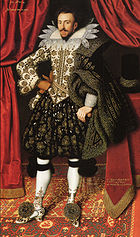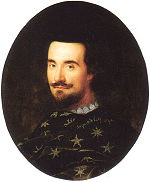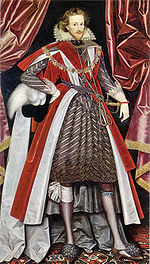
William Larkin
Encyclopedia

England
England is a country that is part of the United Kingdom. It shares land borders with Scotland to the north and Wales to the west; the Irish Sea is to the north west, the Celtic Sea to the south west, with the North Sea to the east and the English Channel to the south separating it from continental...
painter
Painting
Painting is the practice of applying paint, pigment, color or other medium to a surface . The application of the medium is commonly applied to the base with a brush but other objects can be used. In art, the term painting describes both the act and the result of the action. However, painting is...
active from 1609 until his death in 1619, known for his iconic portrait
Portrait
thumb|250px|right|Portrait of [[Thomas Jefferson]] by [[Rembrandt Peale]], 1805. [[New-York Historical Society]].A portrait is a painting, photograph, sculpture, or other artistic representation of a person, in which the face and its expression is predominant. The intent is to display the likeness,...
s of members of the court of James I of England
James I of England
James VI and I was King of Scots as James VI from 24 July 1567 and King of England and Ireland as James I from the union of the English and Scottish crowns on 24 March 1603...
which capture in brilliant detail the opulent layering of textile
Textile
A textile or cloth is a flexible woven material consisting of a network of natural or artificial fibres often referred to as thread or yarn. Yarn is produced by spinning raw fibres of wool, flax, cotton, or other material to produce long strands...
s, embroidery
Embroidery
Embroidery is the art or handicraft of decorating fabric or other materials with needle and thread or yarn. Embroidery may also incorporate other materials such as metal strips, pearls, beads, quills, and sequins....
, lace
Lace
Lace is an openwork fabric, patterned with open holes in the work, made by machine or by hand. The holes can be formed via removal of threads or cloth from a previously woven fabric, but more often open spaces are created as part of the lace fabric. Lace-making is an ancient craft. True lace was...
, and jewellery characteristic of fashion in the Jacobean era
Jacobean era
The Jacobean era refers to the period in English and Scottish history that coincides with the reign of King James VI of Scotland, who also inherited the crown of England in 1603 as James I...
, as well as representing numerous fine examples of oriental carpets in Renaissance painting
Oriental carpets in Renaissance painting
Carpets of Middle-Eastern origin, either from the Ottoman Empire, Armenia, Azerbaijan, the Levant or the Mamluk state of Egypt or Northern Africa, were used as important decorative features in paintings from the 14th century onwards...
.
Life
Larkin was born in LondonLondon
London is the capital city of :England and the :United Kingdom, the largest metropolitan area in the United Kingdom, and the largest urban zone in the European Union by most measures. Located on the River Thames, London has been a major settlement for two millennia, its history going back to its...
in the early 1580s, and lived in the parishes of St Sepulchre-without-Newgate
St Sepulchre-without-Newgate
St Sepulchre-without-Newgate, also known as the Church of the Holy Sepulchre , is an Anglican church in the City of London. It is located on Holborn Viaduct, almost opposite the Old Bailey...
, Holborn, and St Anne Blackfriars
St Ann Blackfriars
St Ann Blackfriars was a London church of the seventeenth century, situated in the ward of Farringdon Within in Church Entry, Carter Lane. It was near the Blackfriars Theatre, a fact which displeased its congregation...
. He became a freeman of the Worshipful Company of Painter-Stainers
Worshipful Company of Painter-Stainers
The Worshipful Company of Painter-Stainers is one of the Livery Companies of the City of London. An organisation of stainers, or painters of metals and wood, is known to have existed as early as 1268. A similar organisation of painters, who generally worked on cloth, existed as early as 1283...
on 7 July 1606 under the patronage of Lady Arbella Stuart
Arbella Stuart
Lady Arbella Stuart was an English Renaissance noblewoman who was for some time considered a possible successor to Queen Elizabeth I on the English throne....
and Edward Seymour, 1st Earl of Hertford
Edward Seymour, 1st Earl of Hertford
Sir Edward Seymour, 1st Baron Beauchamp of Hache and 1st Earl of Hertford, KG was the son of Edward Seymour, 1st Duke of Somerset, by his second wife Anne Stanhope....
. Married before 1612, he buried a stillborn son in that year; a son, William, in 1613; and a daughter, Mary, in January 1614/15, all at St Anne Blackfriars. Another daughter called Mary was alive at the time of his death. He died sometime between the witnessing of his will on 10 April 1619 and its proving
Probate
Probate is the legal process of administering the estate of a deceased person by resolving all claims and distributing the deceased person's property under the valid will. A probate court decides the validity of a testator's will...
on 14 May. The date of his burial is unknown because the parish records were destroyed in the Great Fire of London
Great Fire of London
The Great Fire of London was a major conflagration that swept through the central parts of the English city of London, from Sunday, 2 September to Wednesday, 5 September 1666. The fire gutted the medieval City of London inside the old Roman City Wall...
in 1666.
Works
About 40 portraits by Larkin have been identified, of courtiers and gentry, but he seems never to have painted members of the royal family. A series of nine full-length portraits by Larkin formerly owned by the Earls of SuffolkEarl of Suffolk
Earl of Suffolk is a title that has been created four times in the Peerage of England. The first creation, in tandem with the creation of the title of Earl of Norfolk, came before 1069 in favour of Ralph the Staller; but the title was forfeited by his heir, Ralph de Guader, in 1074...
and now known as the Suffolk Collection is housed in Kenwood House
Kenwood House
Kenwood House is a former stately home, in Hampstead, London, on the northern boundary of Hampstead Heath. It is managed by English Heritage.-History:...
, London
London
London is the capital city of :England and the :United Kingdom, the largest metropolitan area in the United Kingdom, and the largest urban zone in the European Union by most measures. Located on the River Thames, London has been a major settlement for two millennia, its history going back to its...
.
Rediscovery

James Lees-Milne
James Lees-Milne was an English writer and expert on country houses. He was an architectural historian, novelist, and a biographer. He is also remembered as a diarist.-Biography:...
identified Larkin as the painter of two portraits in oil on copper at Charlecote Park
Charlecote Park
Charlecote Park is a grand 16th century country house, surrounded by its own deer park, on the banks of the River Avon in Wellesbourne, about east of Stratford-upon-Avon and south of Warwick, Warwickshire, England. It has been administered by the National Trust since 1946 and is open to the public...
of Lord Herbert of Cherbury
Edward Herbert, 1st Baron Herbert of Cherbury
Edward Herbert, 1st Baron Herbert of Chirbury was an Anglo-Welsh soldier, diplomat, historian, poet and religious philosopher of the Kingdom of England.-Early life:...
and Sir Thomas Lucy III which had formerly been assumed to be the work of Isaac Oliver
Isaac Oliver
Isaac Oliver was a French-born English portrait miniature painter.-Life and work:Born in Rouen, he moved to London in 1568 with his Huguenot parents Peter and Epiphany Oliver to escape the Wars of Religion in France...
. The identification was based on a reference in Herbert's autobiography to a portrait of himself ordered by Richard Sackville, 3rd Earl of Dorset
Richard Sackville, 3rd Earl of Dorset
Richard Sackville, 3rd Earl of Dorset was the son of Robert Sackville, 2nd Earl of Dorset....
, a "Coppy of a Picture which one Larkin a Painter drew for mee, the Originall whereof I intended ... for Sir Thomas Lucy," Cleaning revealed portions of inscriptions that Lees-Milne suggested showed that the oval portraits had been cut down from rectangular originals.
Other documentary evidence of Larkin's work is found in the Diary of Dorset's wife, Lady Anne Clifford
Lady Anne Clifford
Lady Anne Clifford, 14th Baroness de Clifford was the only surviving child of George Clifford, 3rd Earl of Cumberland by his wife Lady Margaret Russell, daughter of Francis Russell, 2nd Earl of Bedford...
, who sat for Larkin in 1619; in the Rutland Papers for 1617 and 1619; and in a seventeenth-century inventory of paintings at Claydon House
Claydon House
Claydon House is a country house in the Aylesbury Vale, Buckinghamshire, England, close to the village of Middle Claydon. It was built between 1757 and 1771 and is now owned by the National Trust....
including a portrait of Frances Carr, Countess of Somerset
Frances Carr, Countess of Somerset
Frances Carr, Countess of Somerset was an English noblewoman who was the central figure in a famous scandal and murder during the reign of King James I...
.
The "Curtain Master"

Roy Strong
Sir Roy Colin Strong FRSL is an English art historian, museum curator, writer, broadcaster and landscape designer. He has been director of both the National Portrait Gallery and the Victoria and Albert Museum in London...
identified Larkin with the artist formerly known as the "Curtain Master" based on Larkin's patronage by the Earl of Dorset. The works of the Curtain Master are characterized by identically draped, silk-fringed curtains framing the sitter, rendered in various colours, and one of several carpets on the floor. The attribution to Larkin is supported by later technical analysis comparing these portraits to the documented portrait of Lord Herbert at Charlecote Park, although various hands are identified in the backgrounds of the full-length portraits, indicating that Larkin employed assistants in his workshop or studio to paint these repetitive details, a common practice at the time.
Critical assessment
Larkin's work marks the last stage in a tradition of English portraiture traceable from the later work of Hans Holbein the YoungerHans Holbein the Younger
Hans Holbein the Younger was a German artist and printmaker who worked in a Northern Renaissance style. He is best known as one of the greatest portraitists of the 16th century. He also produced religious art, satire and Reformation propaganda, and made a significant contribution to the history...
through Nicholas Hilliard
Nicholas Hilliard
Nicholas Hilliard was an English goldsmith and limner best known for his portrait miniatures of members of the courts of Elizabeth I and James I of England. He mostly painted small oval miniatures, but also some larger cabinet miniatures, up to about ten inches tall, and at least two famous...
in which the sitter is painted in flat, lightly modelled fashion, surrounded by meticulously rendered wardrobe and props, with each detail of lace, embroidery, and gilding carefully delineated. Writing in 1960, Sir David Piper said of the paintings now in the Suffolk collection and their ilk "Artistically, they are a dead end, but they have a strange and fascinating splendour." The deaths of Hilliard, Larkin, and fellow-portraitist Robert Peake the Elder
Robert Peake the Elder
Robert Peake the Elder was an English painter active in the later part of Elizabeth I's reign and for most of the reign of James I. In 1604, he was appointed picture maker to the heir to the throne, Prince Henry; and in 1607, serjeant-painter to King James I – a post he shared with John De Critz...
in 1619 mark the end of this insular tradition in British art.

